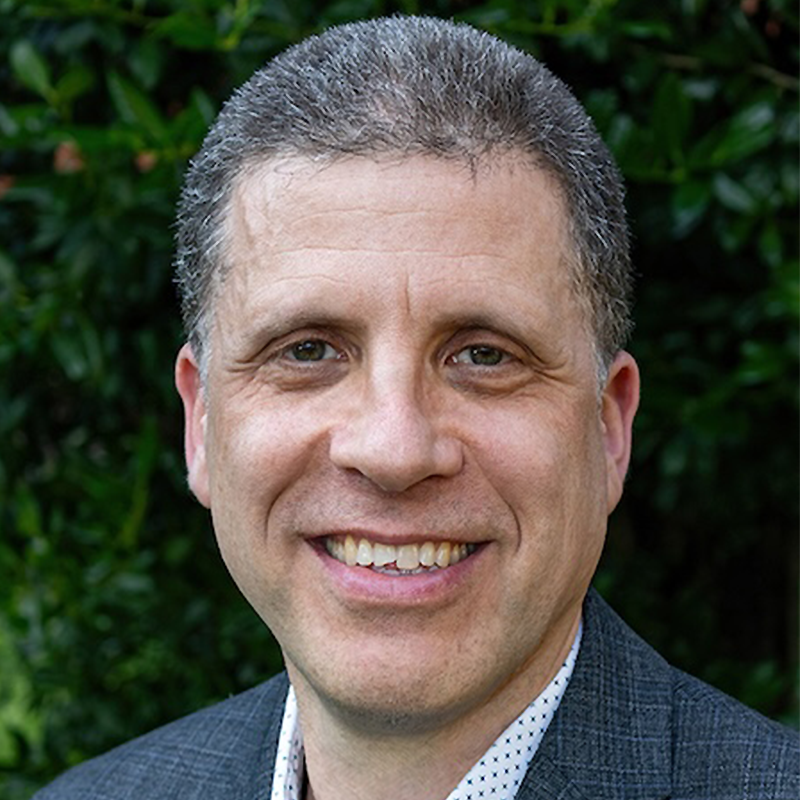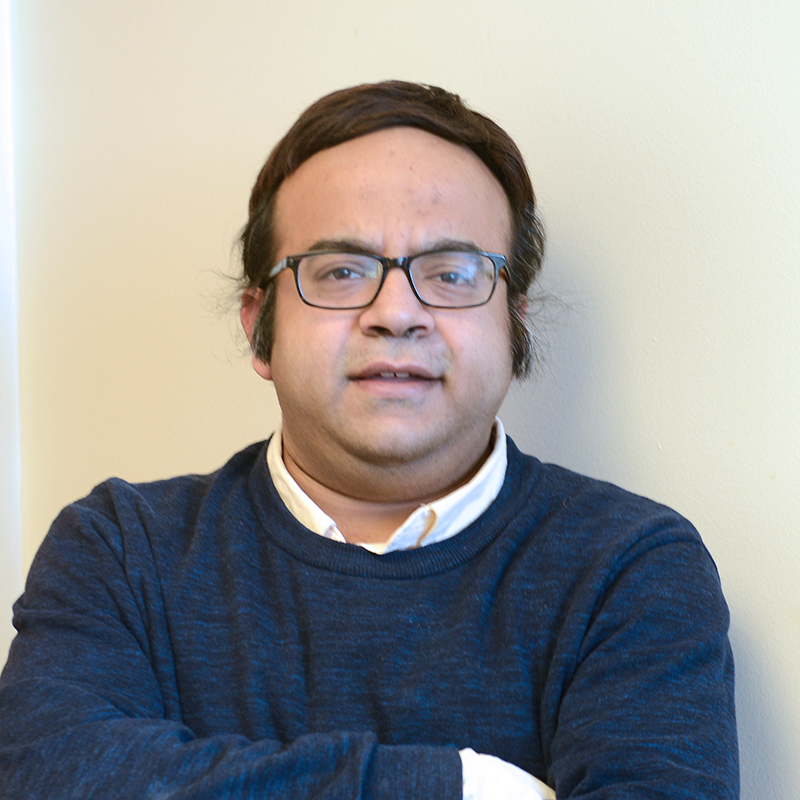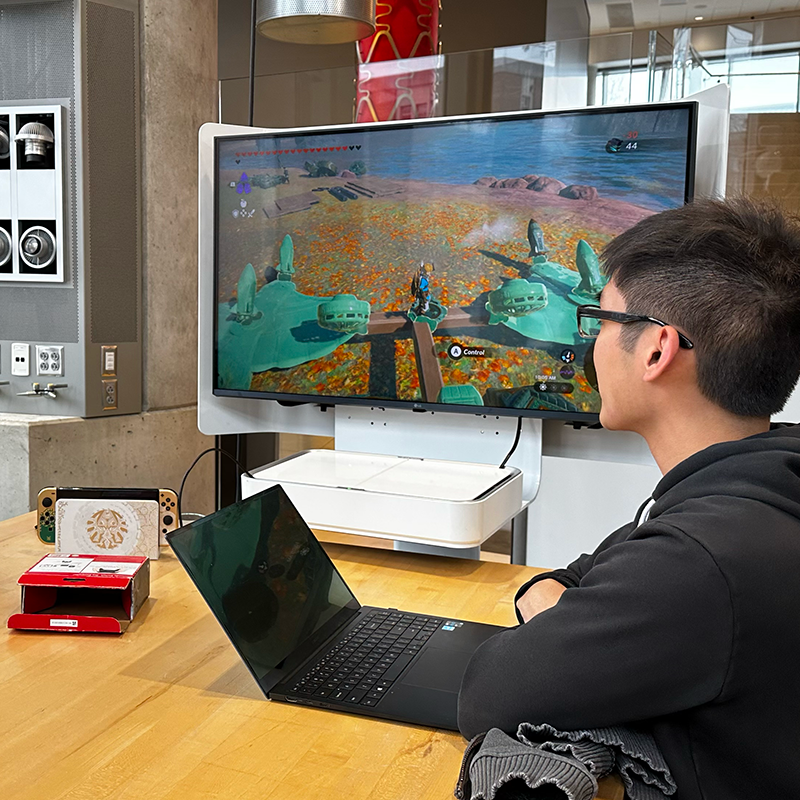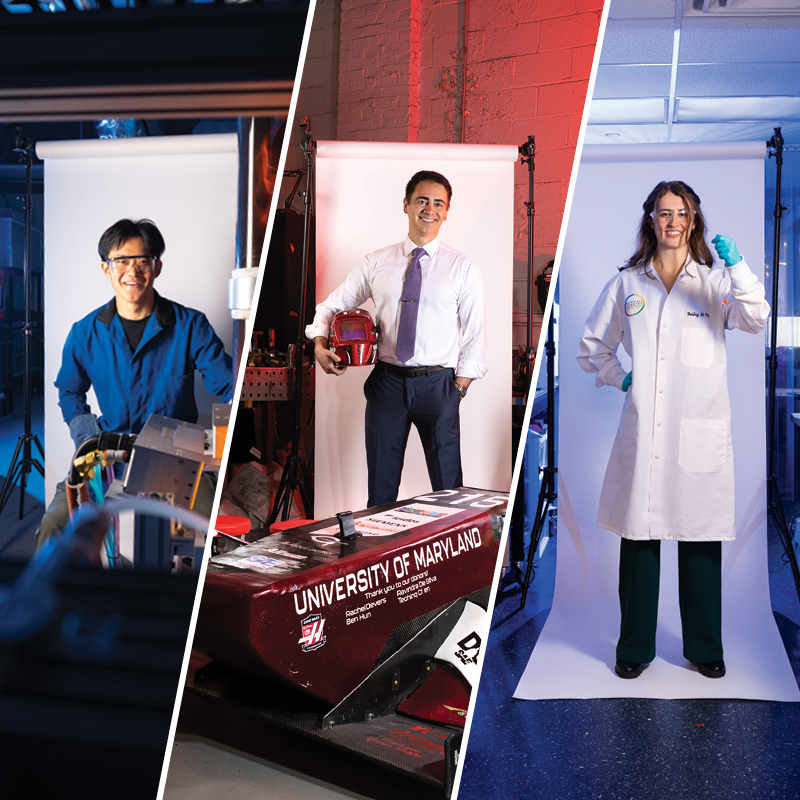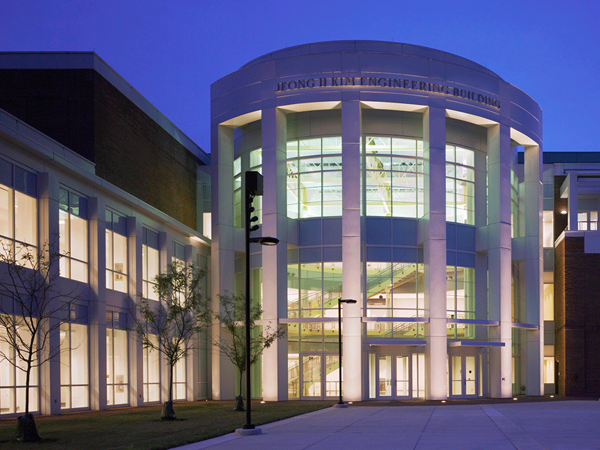News Story
It Takes a Solar Village
High noon. Late summer. The thermometer read 119 degrees over the cracked and sun-blasted asphalt parking lot of a former ConAgra plant outside Charlottesville. It was an instructive lesson in solar energy, but after several sweltering months of 12- and 13-hour days, just another afternoon on the job for a small crew of University of Virginia students here. They were sunburnt. Their hands were blistered. Their T-shirts hung limp with sweat and grime.
They didn't seem to care. In fact, they were nearly offensively cheery, joshing and laughing, blithely oblivious to the withering heat as they went about their work – painstaking business with electric drills, hand tools and crowbars. The subject of their labors was a trailer-size wooden box, open on one side, set on poured concrete cubes. It sprouted a tangle of yellow and orange wiring out the back. It didn't look like much – not yet at least. But this box was going places. This box had big dreams.
This weekend, you can judge for yourself whether those dreams are likely to come true, when the sun rises on the U.S. Department of Energy's inaugural Solar Decathlon. On the National Mall, 14 college and university teams have squared off for the final two weeks of a competition more than four years in the making – to design and build the most efficient, livable and aesthetically inviting home possible, run entirely by the sun.
They've brought their houses, too. From Texas and Alabama, Missouri and Colorado, Virginia, Maryland, Delaware, Pennsylvania, North Carolina and even Puerto Rico, 14 distinct takes on the idea of solar living have been hauled across mountain ranges and along highways, squeezed under overpasses and floated over the ocean by boat. Now they've been assembled in a temporary Solar Village on the Mall. For the next nine days they'll be tested and measured against one another on performance, but also on something more difficult to quantify. Which home, the contest will ask, most successfully marries aesthetics and technology? Which represents not so much the "solar home of the future," but rather the house any one of us might happily and comfortably inhabit today?
An international design jury that includes Australian Glenn Murcutt, this year's winner of the Pritzker Architecture Prize, will be on hand to help make the official call on this question. But the Solar Village is wide open for you to come and form your own opinions on the matter. And while you're there, you might learn a few things about solar energy and energy efficiency that could surprise you – and a few that you can take home and put to good use right now.
Plus, it's all going to be very cool.
The Solar Decathlon is the brainchild of Richard King of the Department of Energy, and to understand what inspired him to dream up this contest, first you need to know a few key points about Americans and energy.
The United States today, with less than 5 percent of the world's population, is responsible for roughly one-quarter of the world's annual energy consumption. Most of that energy comes from burning fossil fuels such as oil, coal and natural gas. It goes to power up our homes and cars and businesses, our coffee makers and CT scans, our 24-hour superstores and three-minute eggs, our economy, our excesses and our necessities. Unfortunately, our fossil fuel habit exacts its price in environmental, health and geopolitical consequences; in particular, it means that the United States is responsible for about one-quarter of the world's annual emissions of carbon dioxide, the chief culprit among global-warming greenhouse gases. Most climate scientists agree that if the world doesn't slash those emissions seriously, and soon, then things are likely to get ugly: rising seas, devastating droughts, catastrophic storms, summers that make this year's heat wave look like a cold snap. Short of pulling the plug on the United States, though, what to do?
Enter King, photovoltaics program team leader in the Department of Energy's Office of Solar Energy Technologies. King, who has been with DOE since 1986, believes that solar is the answer. Clean, free and so abundant that in a single day the sunlight falling on the United States contains more than twice the amount of energy the nation uses in an entire year, solar energy is the way, King says, that "we Americans can reduce carbon and still maintain a high standard of living and quality of life." Worldwide, the market for solar is now growing at 40 percent per year, but here in the States it's still a barely tapped technology. So back in 1998, King started thinking about how he might help us see the light. Because our homes are where each of us individually uses the most energy and where each of us has the power to make a real difference, what King kept imagining was a contest that would demonstrate conclusively "that everyone's rooftop has enough area to provide the energy you need for your daily life."
The idea he finally hit upon was a college-level competition. "Students would design and build solar houses from the ground up and put them side by side in a village to compete with each other in aesthetics and effectiveness," he says. And why not host it on the Mall, thus assuring the competition an unbeatable national stage (never mind the labyrinth of National Park Service regulations to negotiate first)?
King thought up 10 fingers' worth of competition categories, his wife suggested the "decathlon" angle over dinner on a Caribbean vacation. King consulted with colleagues at the National Renewable Energy Laboratory to help devise the rules, and four years after he first came up with the idea – two years after an invitation to take part went out to every architecture and engineering school in the country – he may be the most surprised of anyone to see those 14 houses actually standing on the Mall.
As a measure of the creativity, innovation, dedication and sheer determination it took to get them to the starting line, the Solar Decathlon is already a success. Every team has such a good story, has brought so much enthusiasm and ingenuity to the contest, that it's nearly impossible not to find yourself rooting for all of them to win.
There's tiny Crowder College in Neosho, Mo., for example. The only two-year community college participating in the competition, Crowder also has an impressive solar pedigree: Among other accomplishments, the school built the first solar-powered car to cross the United States. The 12-member team, which includes a 75-year-old grandmother, faced the daunting challenge of raising nearly all of the approximately $150,000 needed to build the house and take it and the team to Washington and back. With pragmatic ingenuity, the students came up with a novel, Internet-age solution. They designed their house, then auctioned it on eBay.
Then there are the students from the University of Puerto Rico. They had to coordinate their project between architecture and engineering campuses 100 miles apart, build their house in a town equidistant between the two and then consign it to a ship on the Atlantic in hurricane season. There was that matter, too, of the occasional language barrier. "Conference calls were a bit of a challenge," says UPR faculty adviser Fernando Abrua. "Students learned that stateside people use acronyms instead of words regularly." It took some time before the team figured out that when Solar Decathlon HQ talked about PR, it was a reference to publicity, not the island commonwealth.
At all of the schools, the students – some of them not even in their twenties – took on the responsibility to raise funds, solicit donations, master solar minutiae, devise and refine house designs, construct models, draw and redraw blueprints and schematics, write programming, build Web sites, work the phones, manage PR, solve every new crop of problems, run wiring, bang nails, drive the forklift, test equipment, make the pizza runs and labor under the summer sun. Item by item and day by day, the students puzzled their ways through what amounted to 14 ambitious experiments in educated guesswork.
"I have a budget of $200,000, and I'm moving a 45,000-pound house to D.C. What other student gets an opportunity like that?" says Alex Yasbek, a senior and project manager for the all-undergraduate University of Maryland team.
Adam Ruffin, a project manager for the University of Virginia team who completed his graduate architecture degree in May, says that when he took up a hammer to start work on the house this spring, he'd never built anything except skateboard ramps. "To get down to the scale of nail and boards and cladding and how water is going to creep into a building – most people coming out of an architecture program don't know how to do this," he says.
The acid test for all that work starts Monday, when the students begin five days of living in the homes – cooking meals, doing laundry and dishes, running the shower, watching television, using the computer – in short, engaging in the usual energy-consuming activities of a typical American home. They'll even have to run errands; the DOE supplied each team with a Ford Think Neighbor electric vehicle, which has to be charged from the house's power for use on designated trips around town. (King points out that the average American household expends roughly as much energy on transportation as it does in the home.)
Each home was required to include a kitchen, a bathroom, a bedroom, a living area and even a home office, all of it squeezed into a minimum of 450 square feet, with a footprint of no more than 800 square feet. Each home has to run entirely on the solar energy it can capture through its own systems. The devil in the details here is a multi-page set of specifics about the number of towels and place settings to be washed every day, the number of meals cooked, the hours the lights and the TV have to stay on. The water in the shower has to be hot and the drinks in the fridge have to keep cold, the oven has to cook, the computer compute. Appliances have to be full-size, too – no dorm refrigerators or one-burner stoves here. Climate controls have to maintain interior living areas at a constant 72 degrees Fahrenheit, regardless of whatever weather the District may be dishing out.
Monitoring equipment will take constant readings from more than 480 "data points" altogether among the 14 homes, measuring everything from room, hot water and refrigerator temperatures to the amount of light falling on the home office desktop and will track how much energy is being used to run all these systems.
"This is not only a contest," says King. "You have fully instrumented houses that will be compared side by side. That information is going to be very valuable to the scientific community as well as to the Department of Energy."
Come Saturday, Oct. 5, the team with the most points wins. Strictly speaking, what they'll get for their success is . . . a trophy. But everyone taking part in the competition knows that as an educational experience, as a research and development laboratory, as a uniquely imaginative demonstration of solar energy at work, the Solar Decathlon has already proved its value.
"This project, if it's successful, will change the way people live. It will change the way we think," says U-Va. student Charlotte Barrows.
All that makes winning almost beside the point. Almost.
And what will it take to win the Solar Decathlon? For this first one, no one, not even King, is altogether sure. "It's kind of a grand experiment," he says. "As far as 'the wild factor,' this will be the cool one. You'll walk through the village going, 'Wow, look at what this team did, look at what that team did.' "
With no precedent to go by, each of the 14 homes represents a wholly original solution to the Decathlon challenge. The result is so remarkably varied, so imaginatively different a group of homes, that the Solar Village is a must-visit, even if your idea of alternative energy is choosing between premium and ultra at the gas pump.
"I think all of us will be oohing and aahing," says King.
Among the entries from Maryland and Virginia, the Virginia Tech house is progressively experimental, suggesting an industrial-chic beach home. Its bones show in an external structure of pultruded fiber-glass beams, but inside it's all about light, thanks to translucent east and west wall panels filled with an ultra-insulating material called Nanogel.
"One of the focuses that we tried to use in the building was to have materials that had different physical characteristics or attributes than you would find in a normal building," explains Robert Schubert, faculty coordinator for the Tech team.
The house has a movable interior wall with a fold-up bed on one side and a fold-up table on the other that lets the living space be reconfigured for day and night uses. Warm, durable and sustainably harvested bamboo is used for floors, walls, even cabinet facings. There's also locally quarried granite underfoot; heated by the sun, it stays warm long after night falls.
The University of Maryland team incorporated sustainable features (such as bamboo flooring) and progressive technologies (including exterior siding made from cement and recycled newspaper), but built them into a house that could slip unobtrusively into any American suburb.
"We are trying to focus on the fact that solar power is viable right now," says Yasbek. "We tried to stick to a familiar style so the general public would be comfortable with it."
"Our house looks like a house down the street, like something you can build right now," adds Maryland assistant project manager Catherine Buxton. At first, she admits, with an all-engineering team, "Everyone was fighting over who would do the HVAC, the plumbing. No one wanted to do the design."
The opposite was the case at the University of Virginia, where project manager Ruffin admits, "The architecture has kind of taken over, for better or for worse." The U-Va. house, clad in reclaimed copper beneath slatted rain screens made from salvaged wood from shipping pallets, and topped by a small rooftop garden, balances a warm, organic look with a modernist pedigree.
Among other teams, the University of Delaware categorizes its semicircular house as "experimental." The Tuskegee University house is a two-level with a loft and an outdoor catwalk to a second-story screened porch. The Carnegie Mellon University entry is the top-floor apartment of an urban townhouse. The University of Colorado team, wanting to banish forever the "cheese wedge" solar aesthetic of the 1970s – a roof with a house attached – devised a prototype for a mass-producible, modular, sustainable home system. It has a bathroom floor made from recycled auto vinyl.
The University of Texas at Austin and Auburn University both drew on the traditional Southern "dogtrot" design (a central, front-to-back corridor that creates natural, cooling air flow) for their homes. "Our house is southern vernacular," claims Auburn faculty adviser Henry Brandhorst. "All we need is a couple of hound dogs on the porch and rusting cars in the front up on cinder blocks."
As for Texas, that team took the novel, even whimsical approach of framing their home around an Airstream trailer that houses the kitchen, bath and laundry functions. Was it a tongue-in-cheek nod to another kind of Southern tradition? The team isn't saying, and they offer you plenty of straight-faced and perfectly legitimate arguments on behalf of their "mobile utility environment," but Texas faculty adviser Michael Garrison admits, "We all agreed that our style is to create 'commotion.' "
Inside, the houses balance aesthetics with efficiency – it's the Home Show meets Honey, I Shrunk the Electric Bill.
"We want consumers to realize that living with alternative energy supplies need not change your lifestyle," says Auburn's Brandhorst. "We have used appliances that you and I can go out and buy, but with a focus on energy efficiency." As a result, he says, "We believe we are going to be using on the order of one-half less energy per square foot than a normal house."
That lesson in efficiency is the one thing any one of us can take away from the Decathlon that could yield immediate benefits for everyone. Use less electricity, and you pay less on your bill and incrementally reduce our nation's collective carbon output. Save the planet and save a buck – hard to complain about that. Here's where a strolling tour of the Solar Village could be well worth your while.
Maybe the super-efficient Fisher & Paykel dish drawer (that's "dishwasher" to you and me) isn't for you. Well, how about that Kenmore refrigerator, then, the one that'll take a whopping bite out of your electric bill? Or those compact fluorescent light bulbs, available at any Home Depot? Talk to Joshua Galloway on the U-Va. team about the rooftop garden, a green oasis that insulates the house, helps control rainwater runoff, reduces the "heat footprint" of a roof baking in the sun all day and just happens to make a lovely place to sit. Look for team manager Kelly Gossett lounging in the Crowder College house's outdoor hot tub, thanks to a Sybaritic harvest of hot water from hybrid solar panels the team created that generate electricity and heat water at the same time.
The University of Colorado team's faculty adviser, Michael Brandemuehl, hopes that after visiting the Solar Village, we'll all start asking, "If a bunch of college kids can do this, why can't the building industry do this?"
Earlier this summer, on a day with code-red air quality when the breeze blew stiflingly hot and dry through the still-unfinished Maryland house, Alex Yasbek and Catherine Buxton reflected on their own hopes for the Decathlon.
"Most of the skeptical people are amazed that we can create enough power to power the whole house," says Buxton. "But when we tell them you're collecting energy you don't have to pay for, plus also saving 70 tons of pollution a year, they are less skeptical."
At the Decathlon, says Buxton, "I would feel good if people walked away saying, 'Wow, I could do that.' "
Published September 27, 2002
